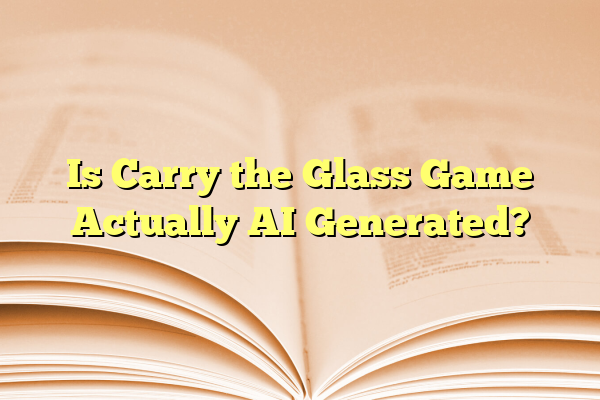
Is Carry the Glass Game Actually AI Generated?
As indie games continue to flourish, new titles that push the boundaries between technology and creativity are regularly introduced. One such game is Carry the Glass, a minimalist puzzle adventure that has recently gained attention not only for its unique gameplay but also for a central question: Was Carry the Glass generated by artificial intelligence? The answer is not as straightforward as one might assume, and understanding the foundation of the game requires a deep dive into modern AI capabilities, the development process, and statements from the game’s creators.
Contents
The Rise of AI in Game Development
Before addressing whether or not Carry the Glass was AI-generated, it’s essential to understand the current landscape of AI in gaming. Contemporary game development can incorporate AI in several ways:
- Procedural content generation – Algorithms create levels, maps, or entire worlds dynamically.
- AI-generated dialogue – Natural language processing models can draft realistic character conversations.
- Image and design assistance – Visual assets might be partially designed using machine learning tools.
- Testing and quality assurance – AI can identify bugs and optimize gameplay balance.
These applications show that AI may not necessarily create a game outright, but can play a considerable role throughout the development cycle.
What Is Carry the Glass?
Carry the Glass is a quietly captivating puzzle game that puts the player in control of fragile, physics-based objects that must be carried through increasingly complex environments without breaking. The game’s tone, art style, and ambient soundtrack combine to deliver a strangely meditative yet unnerving experience. It’s been praised for its minimalist design and strange, dreamlike logic.
Many players have found aspects of the game to feel “non-human” or “generated,” leading to speculation that AI may be heavily involved, or even the primary creator. This perception is shaped by several characteristics:
- Ambiguous narrative elements – The story does not follow traditional structure. Scenes shift without clear reason, leaving interpretation open.
- Inconsistent object behavior – Some puzzle mechanics appear unpredictable, possibly hinting at procedural or AI-generated logic systems.
- Visual motifs – The game includes repetitive but slightly altered art, suggesting the use of generative AI imagery.
The question then becomes more than curiosity—it’s about whether the design decisions stem from human artistic vision or an algorithm trained to replicate one.

Statements from the Developers
The name of the game’s supposed developer is “Monoverse Atelier,” a studio that has minimal online presence and no previous game development history. Their website consists of a few poetic quotes, a download link to the game, and cryptic notes written in a mix of human language and code-like syntax. No developer credits are listed, and multiple attempts by gaming journalists to contact the creators have gone unanswered.
This silence has only fueled theories that the game might be an AI experiment or an art collective using AI to explore themes of digital consciousness. However, some community-based investigations have turned up potential clues:
- GitHub repositories under usernames similar to “MonoverseAtelier” show machine learning frameworks and generative environment scripts.
- The game’s install files include unused resources labeled with model names matching known neural network architectures.
- The executable scripts contain references to common Python-based AI libraries such as TensorFlow and PyTorch.
In developer forums, a few anonymous users have claimed to be part of the project or to know inside details. One such post reads:
“Carry the Glass was shaped by a collaboration of artists and recurrent neural networks. It is not AI versus human—it’s synthesis.”
Is the Game Fully AI-Generated?
Despite hints of AI involvement, claiming that Carry the Glass is entirely AI-generated would be inaccurate.
Developing a fully functioning game still requires extensive human oversight, particularly in areas like:
- User interface design
- Performance optimization
- Bug fixing and compliance testing
- Distribution and marketing
Even the most advanced generative models, such as ChatGPT combined with image generators like Midjourney or DALL·E, require clear guidance and post-processing by human creators. While these tools can accelerate creative workflows, they are currently not autonomous creators of cohesive video games.
Dissecting the Gameplay Experience
Some aspects of Carry the Glass do feel like they emerge from a machine’s interpretation of how games should play. For example:
- The puzzles have an irrational logic, solved more by trial and eerie emotional response than structured reasoning.
- The soundtrack contains audio anomalies—tones that waver between harmony and dissonance—that suggest an algorithm is shaping music dynamically.
- Certain objects reappear in different colors or states, which could point to automated asset transformation rather than deliberate design variation.

All this supports the idea of some level of procedural generation or ML-driven content inclusion. However, AI appears to augment rather than replace traditional processes.
The Future of AI-Created Games
What Carry the Glass represents may not be an anomaly, but a glimpse into the future of digital art and interactive entertainment. As AI tools continue to advance, developers are discovering new ways to incorporate machine assistance without diluting their artistic vision.
This leads to a distinction that is gaining importance in both academic and commercial discussions:
- AI-assisted design: Where AI helps create art, levels, or narrative options based on inputs from a human creator.
- AI-directed projects: Where AI plays a significant role in forming the structure or identity of a creative project.
- AI-generated artifacts: Projects realized almost entirely through machine learning processes with minimal human touch, often experimental in nature.
Carry the Glass fits somewhere between the second and third categories. While it relies on foundational programming and aesthetic guidance from human creators, the feel of the game implies autonomy—decisions that seem to reflect a logic foreign to human perception.
Conclusion
Is Carry the Glass actually AI-generated? The most credible conclusion is that it is a hybrid creation. While not entirely the product of a machine, it is strongly shaped by AI tools and perhaps even designed, in part, to explore what AI can achieve when minimally directed by humans.
Games like Carry the Glass push the limits of how we define authorship and creativity. They compel players to consider not just what the game is, but who—or what—made it. In doing so, they leave us staring into the blurry, reflective interface between artistic intent and artificial inference.
